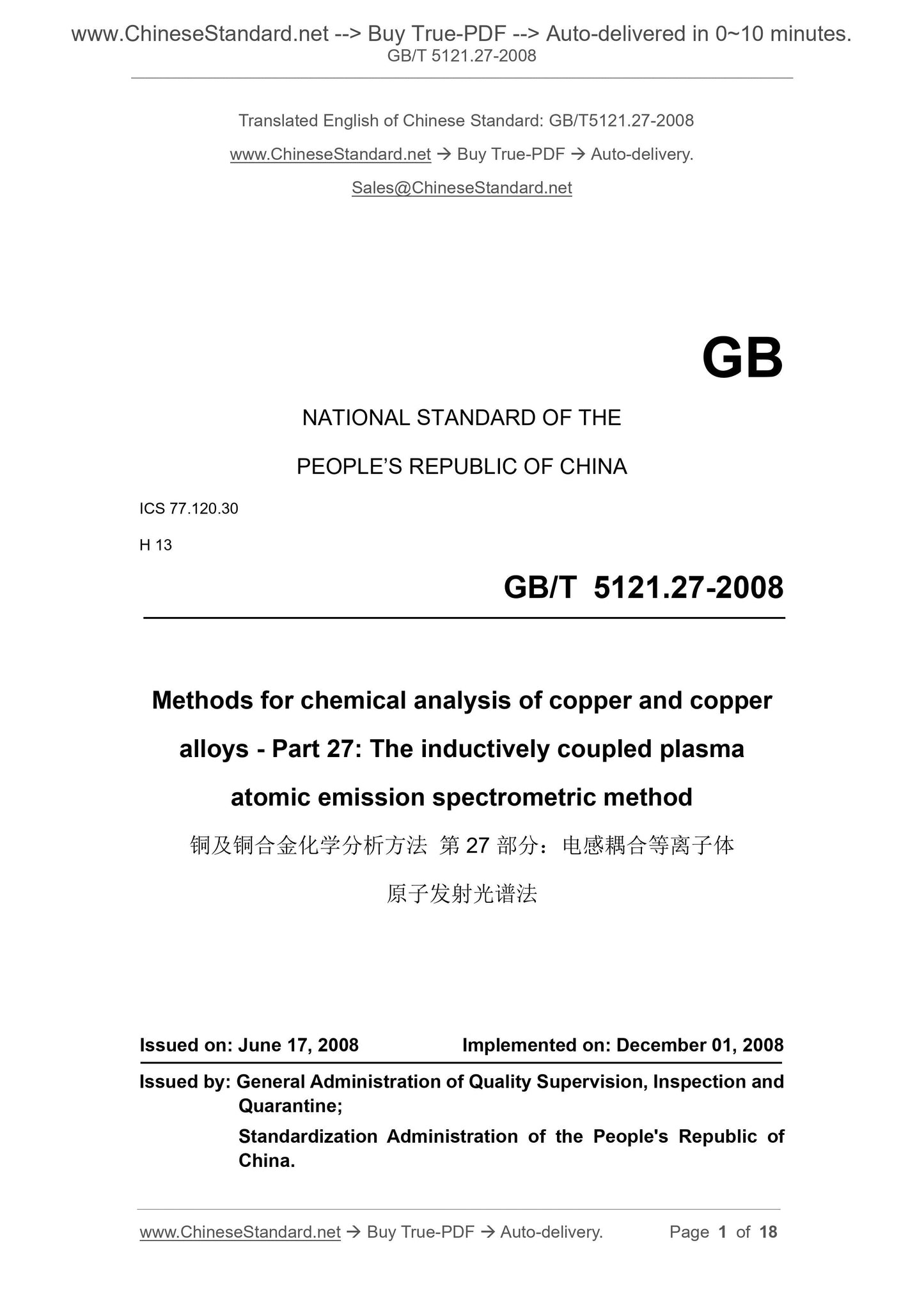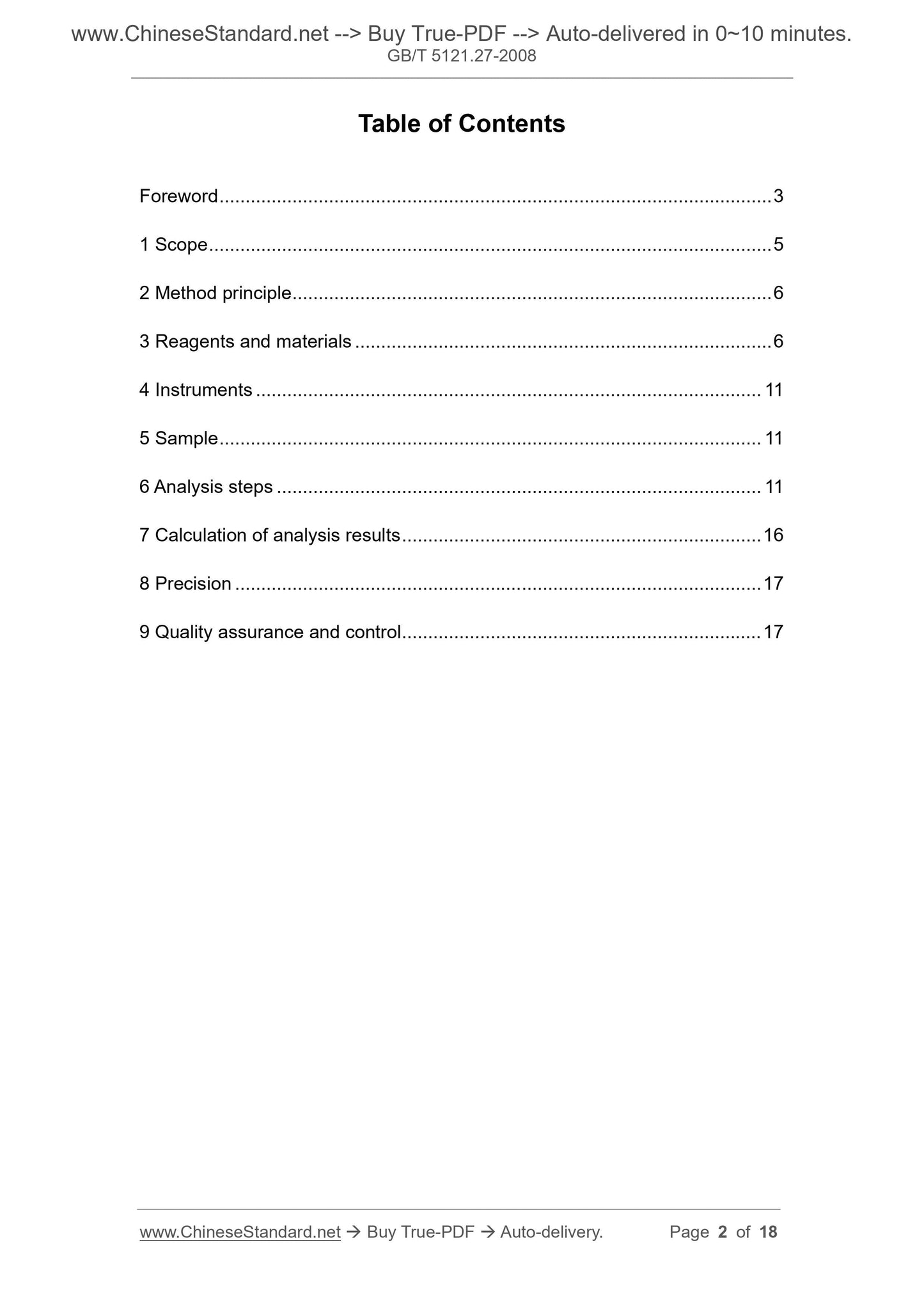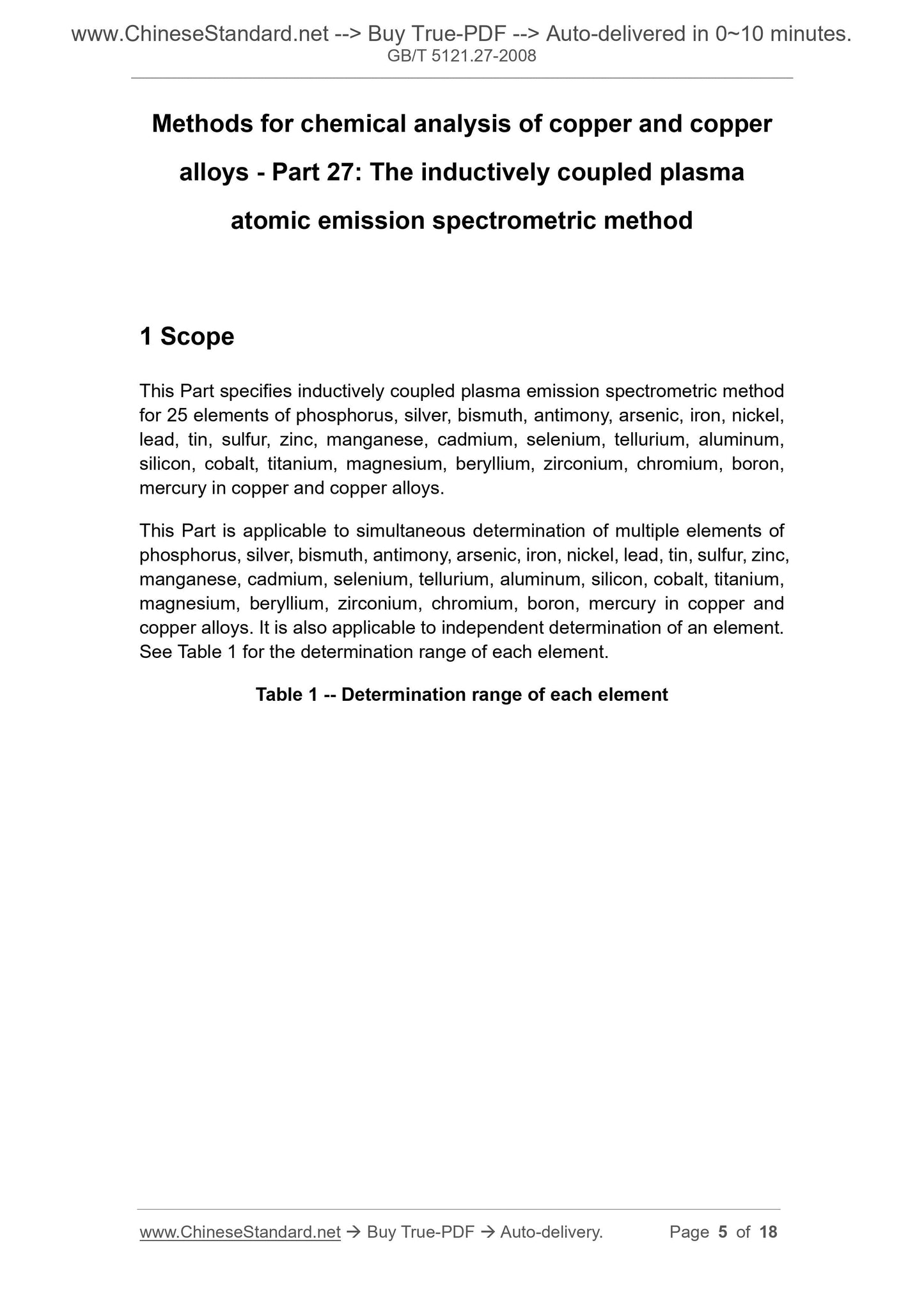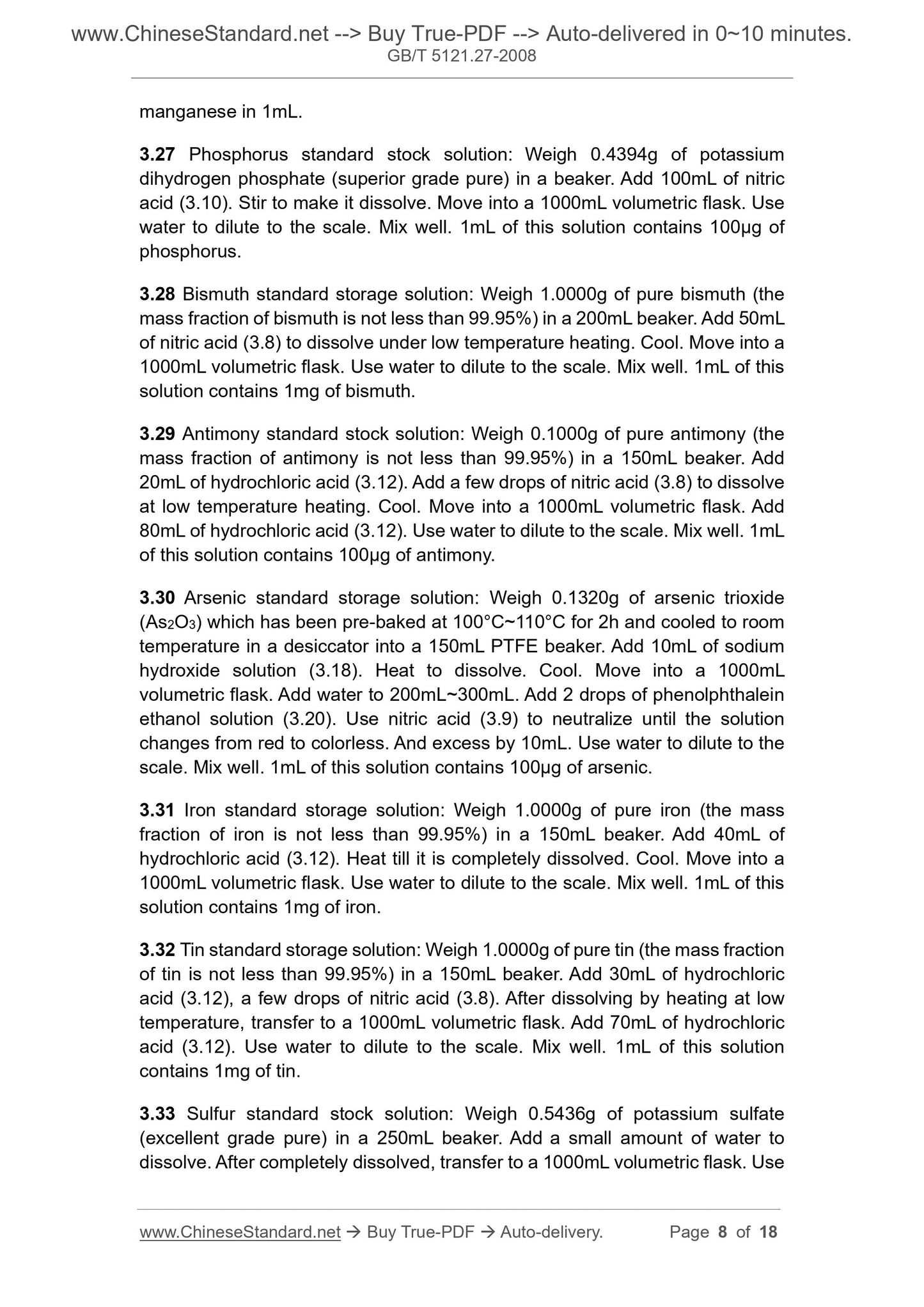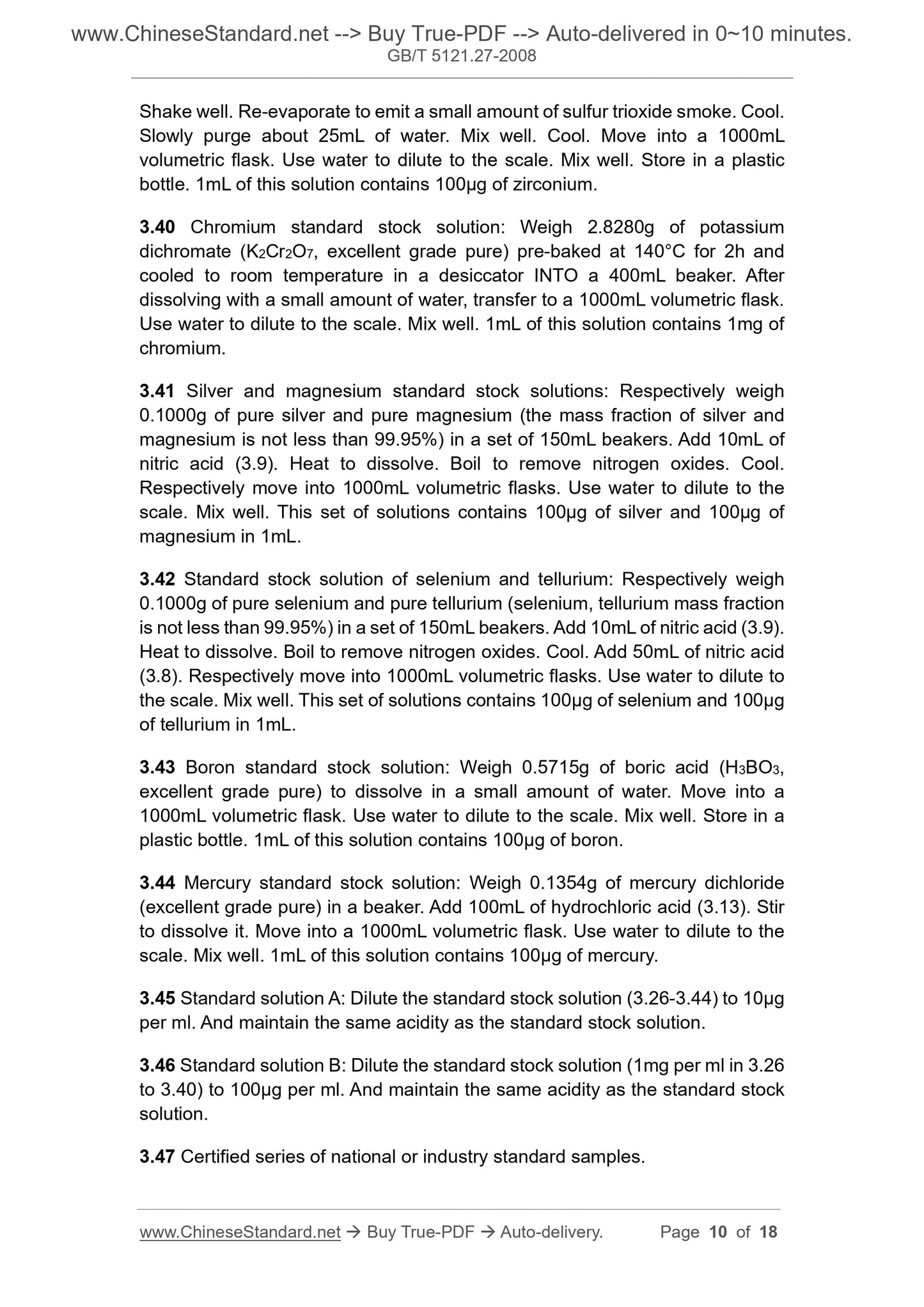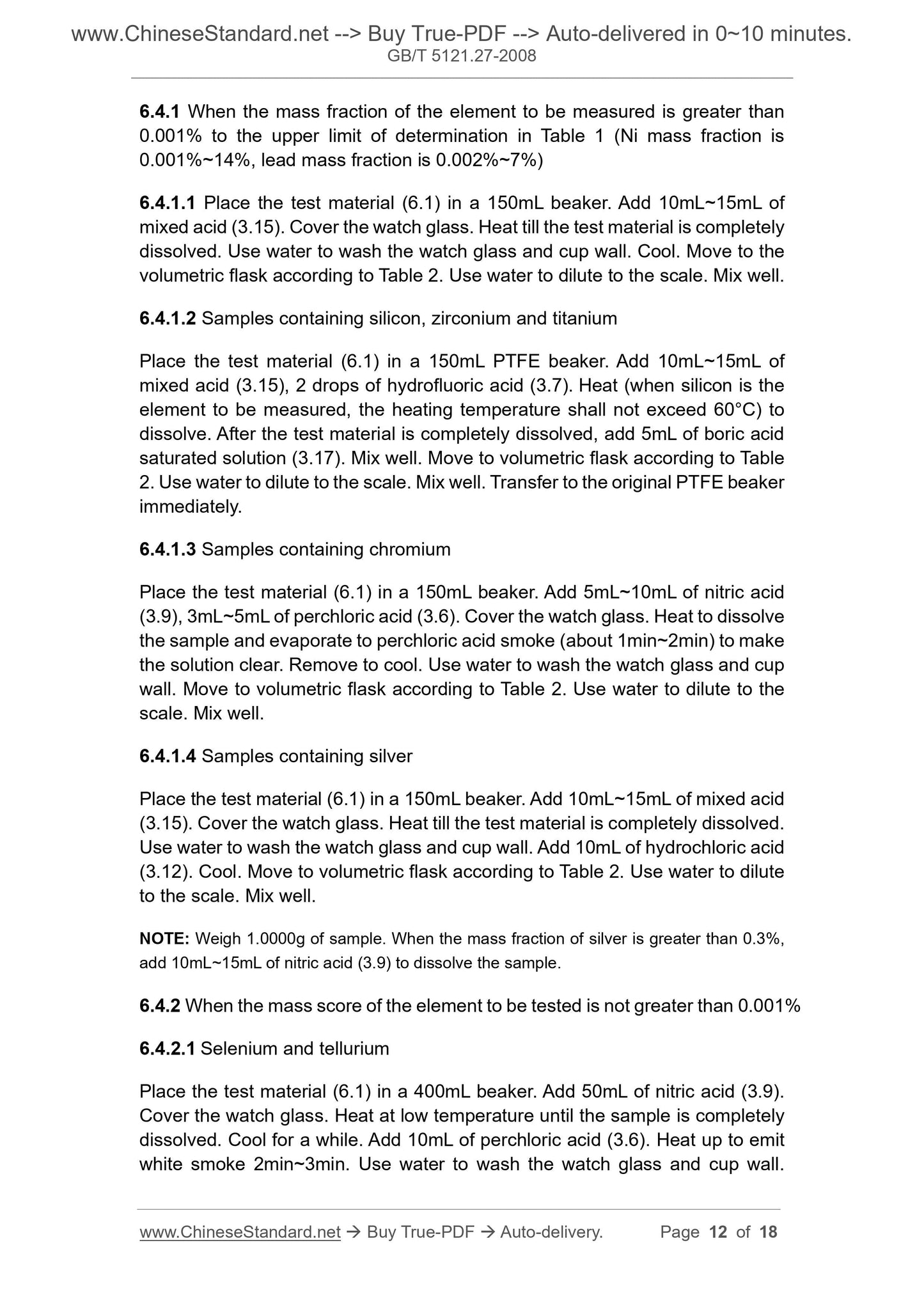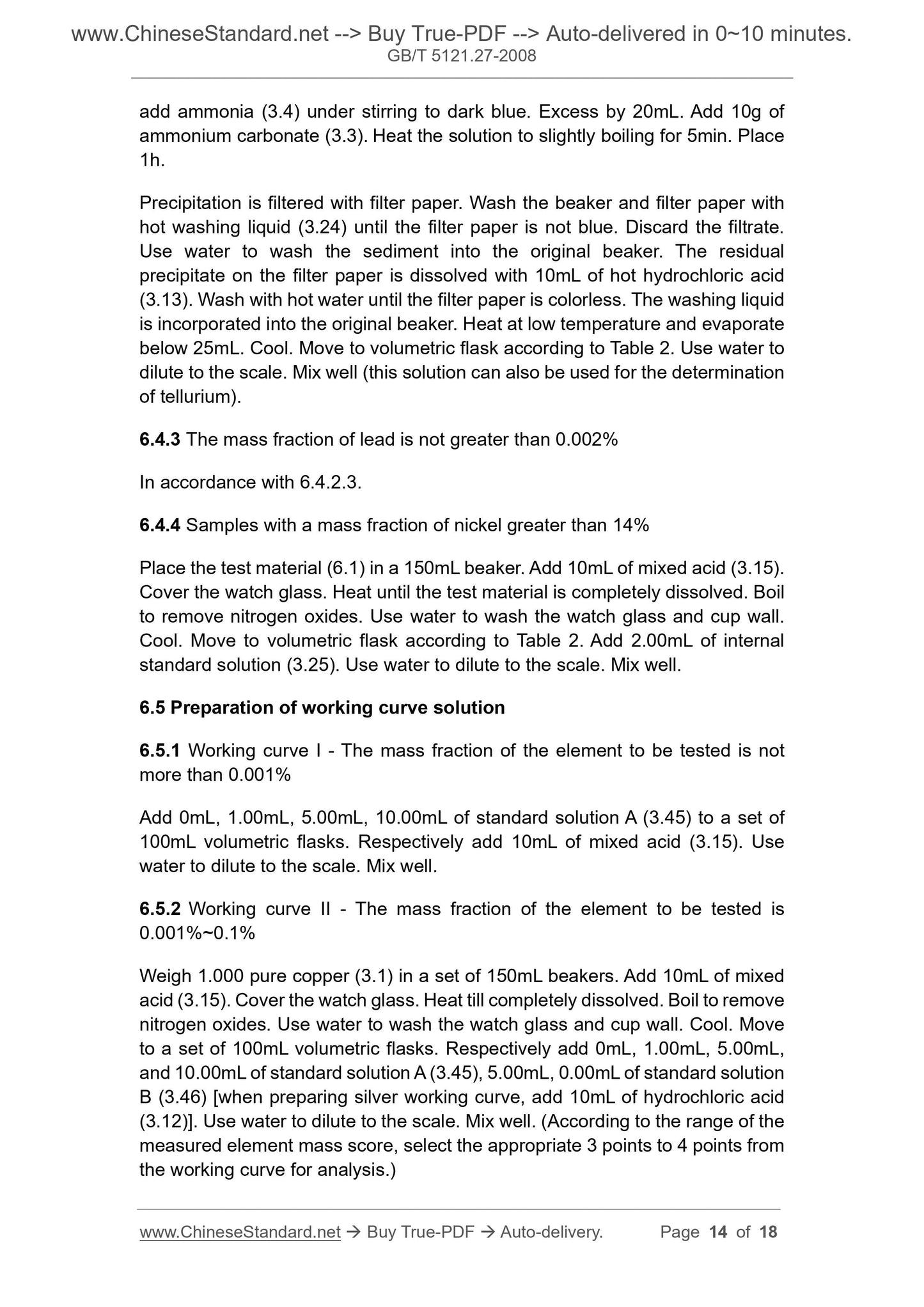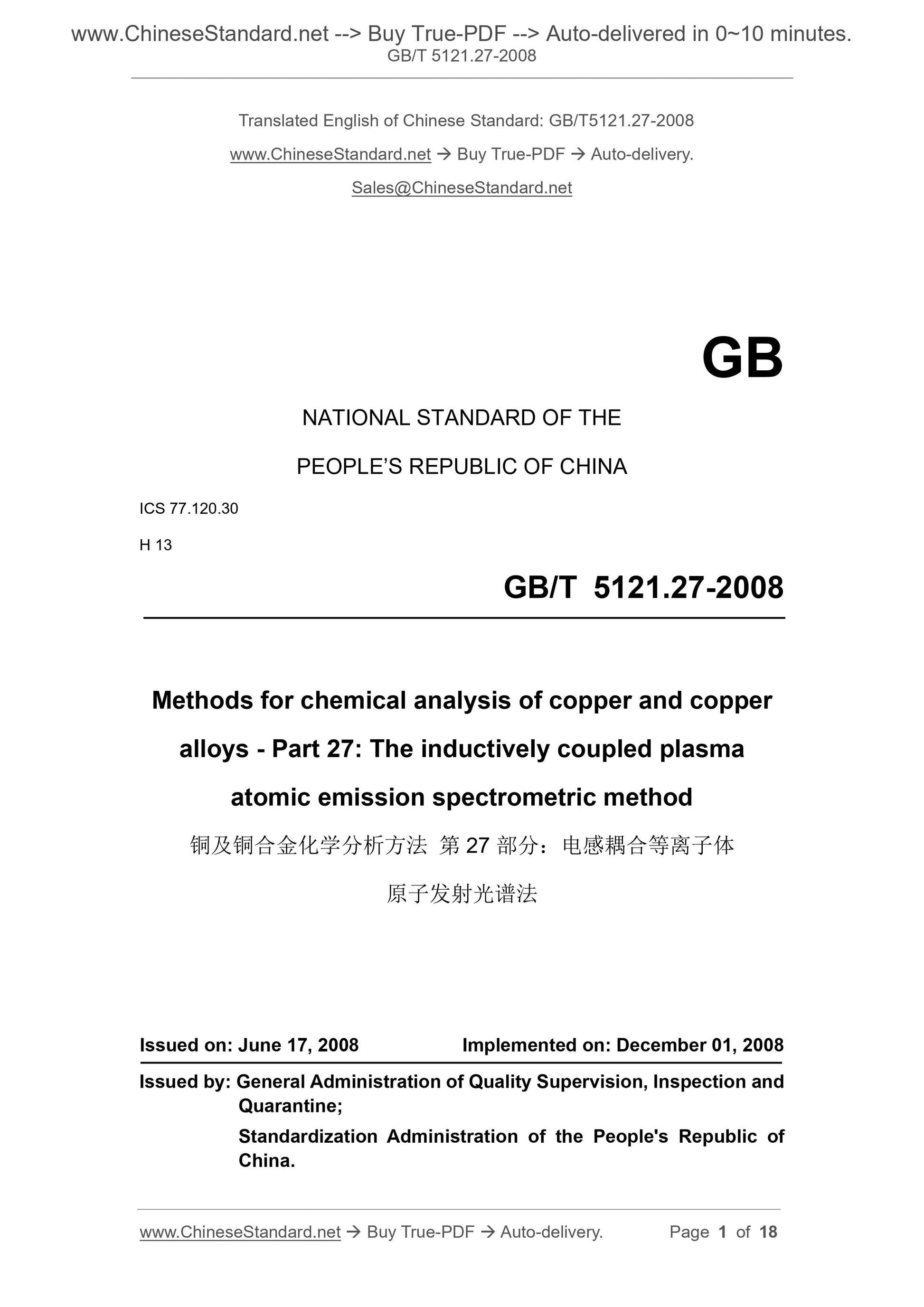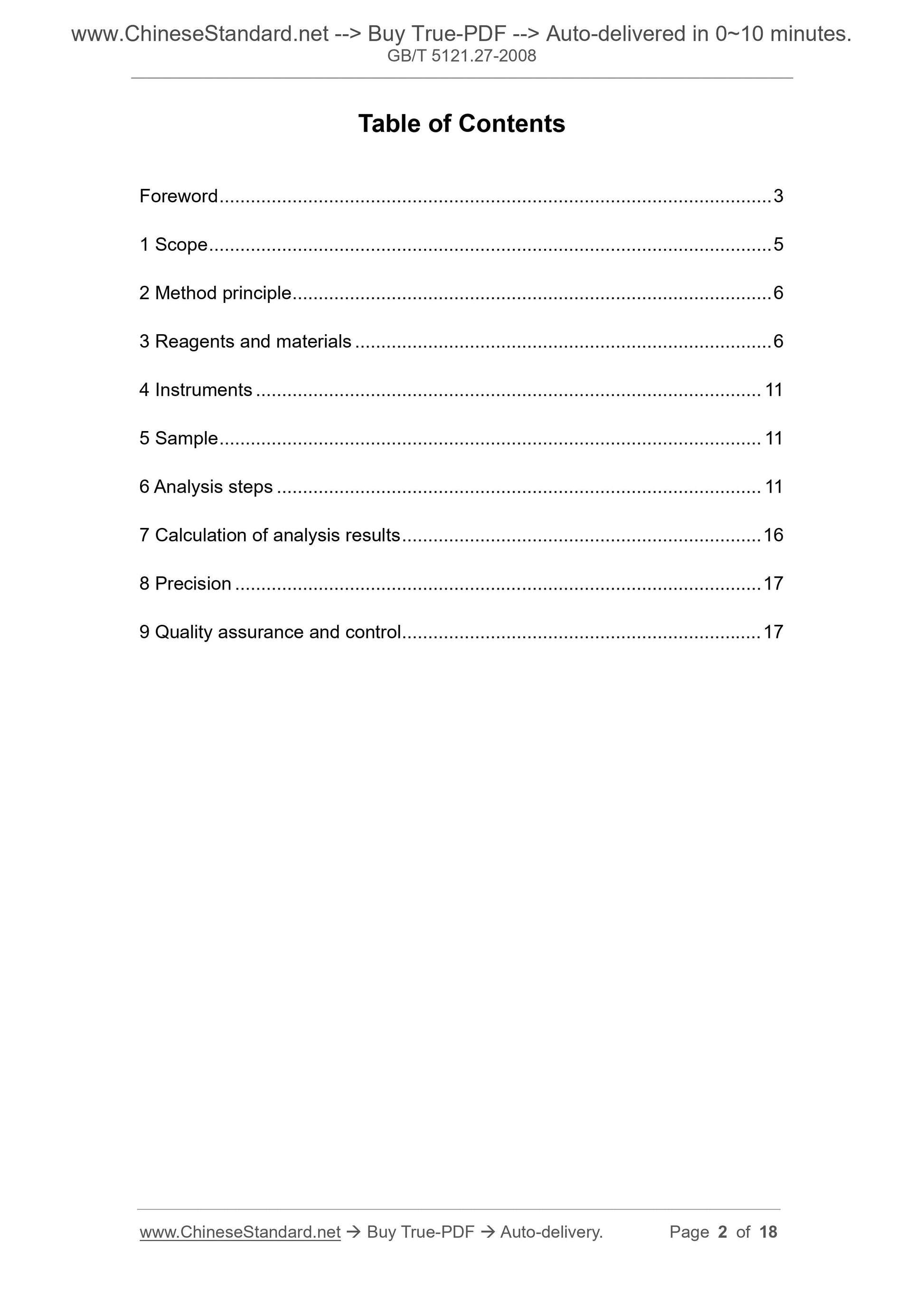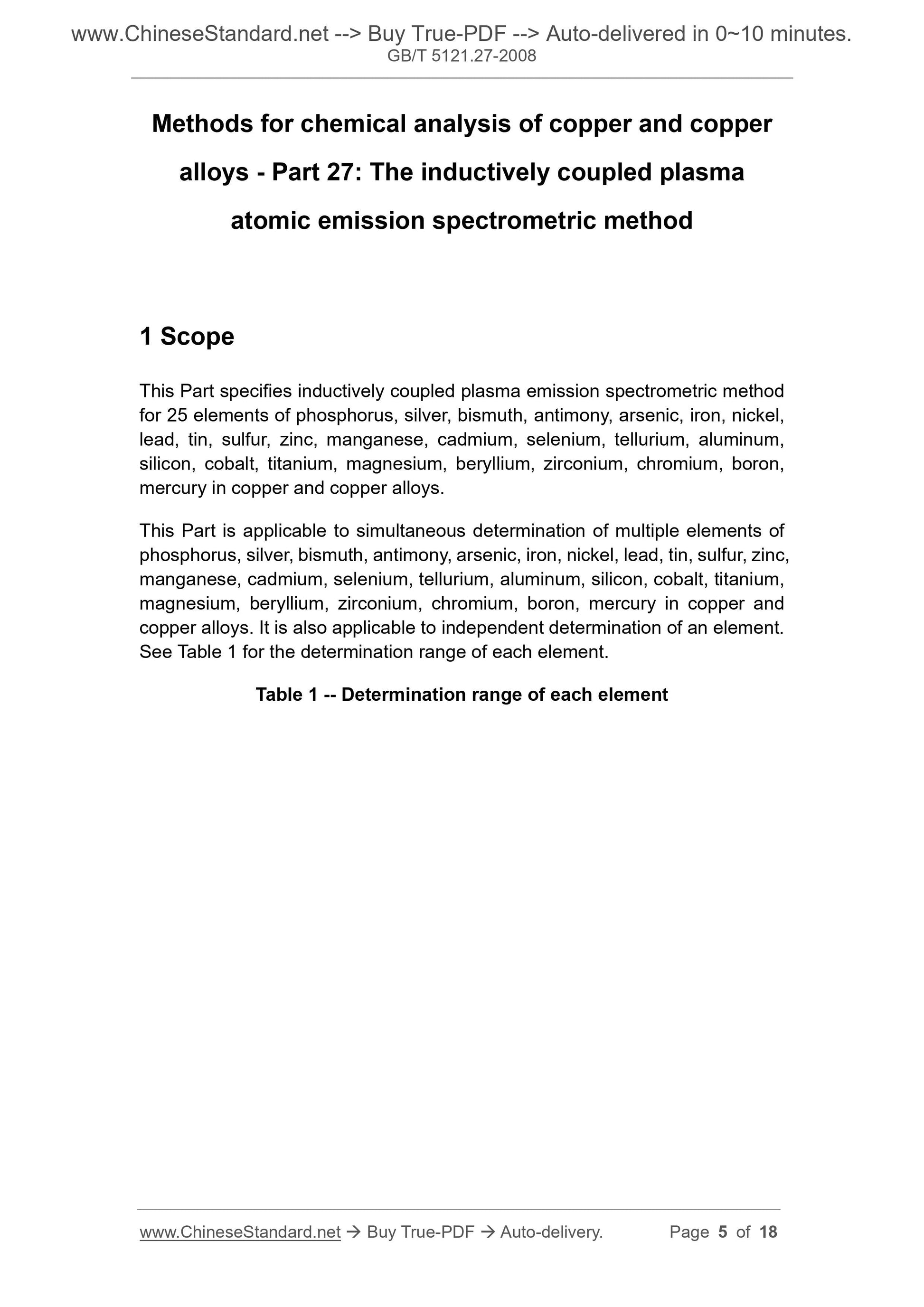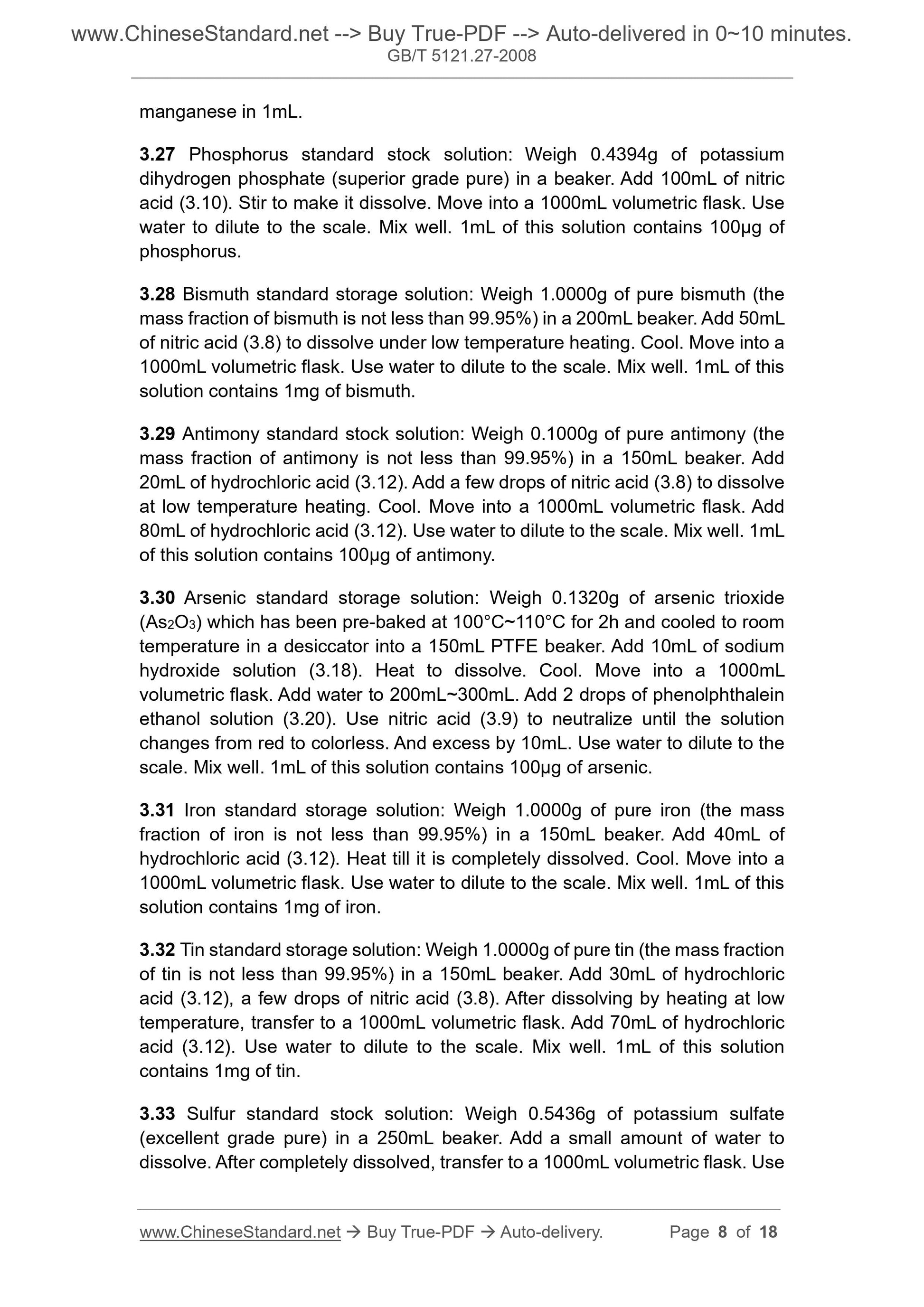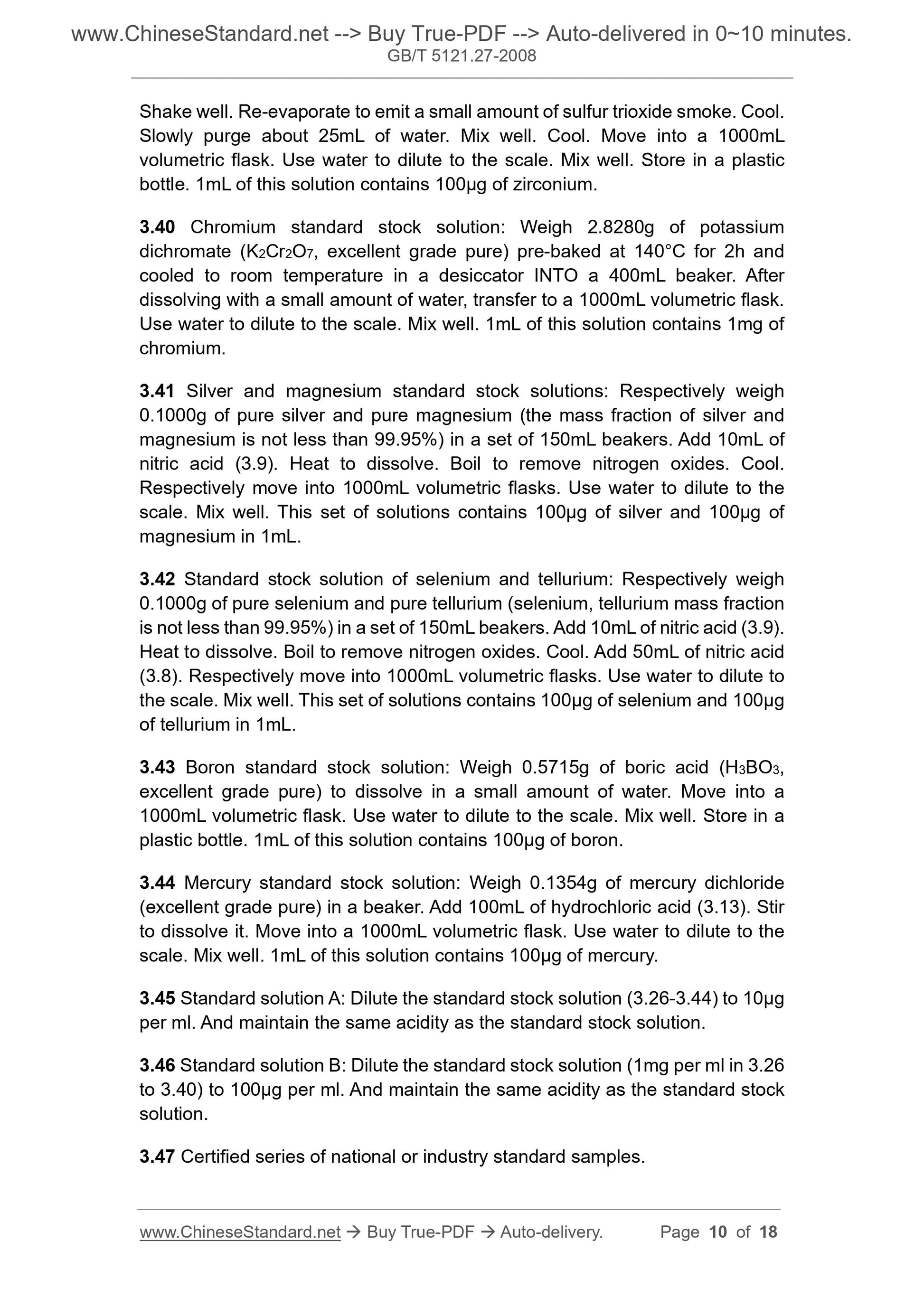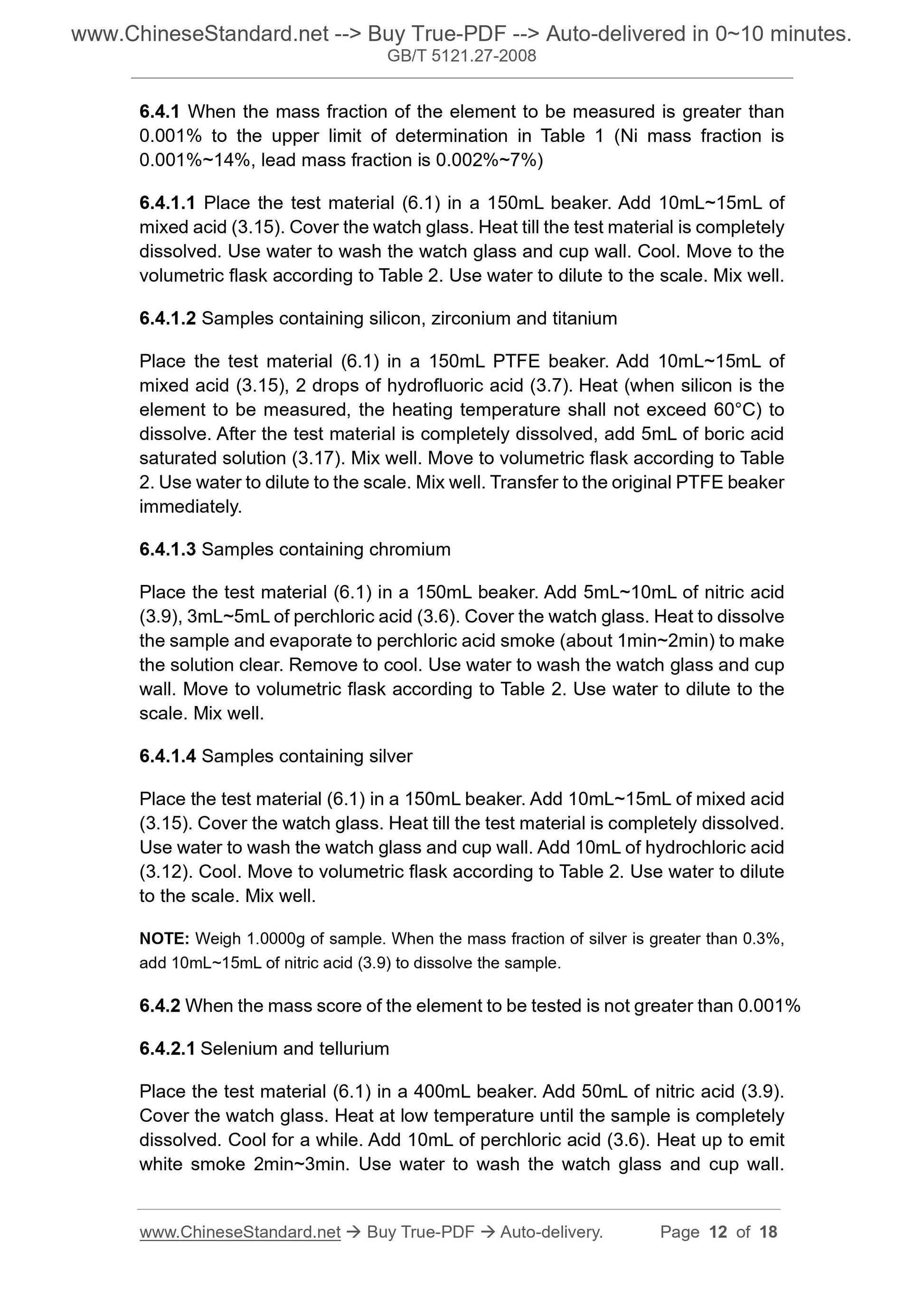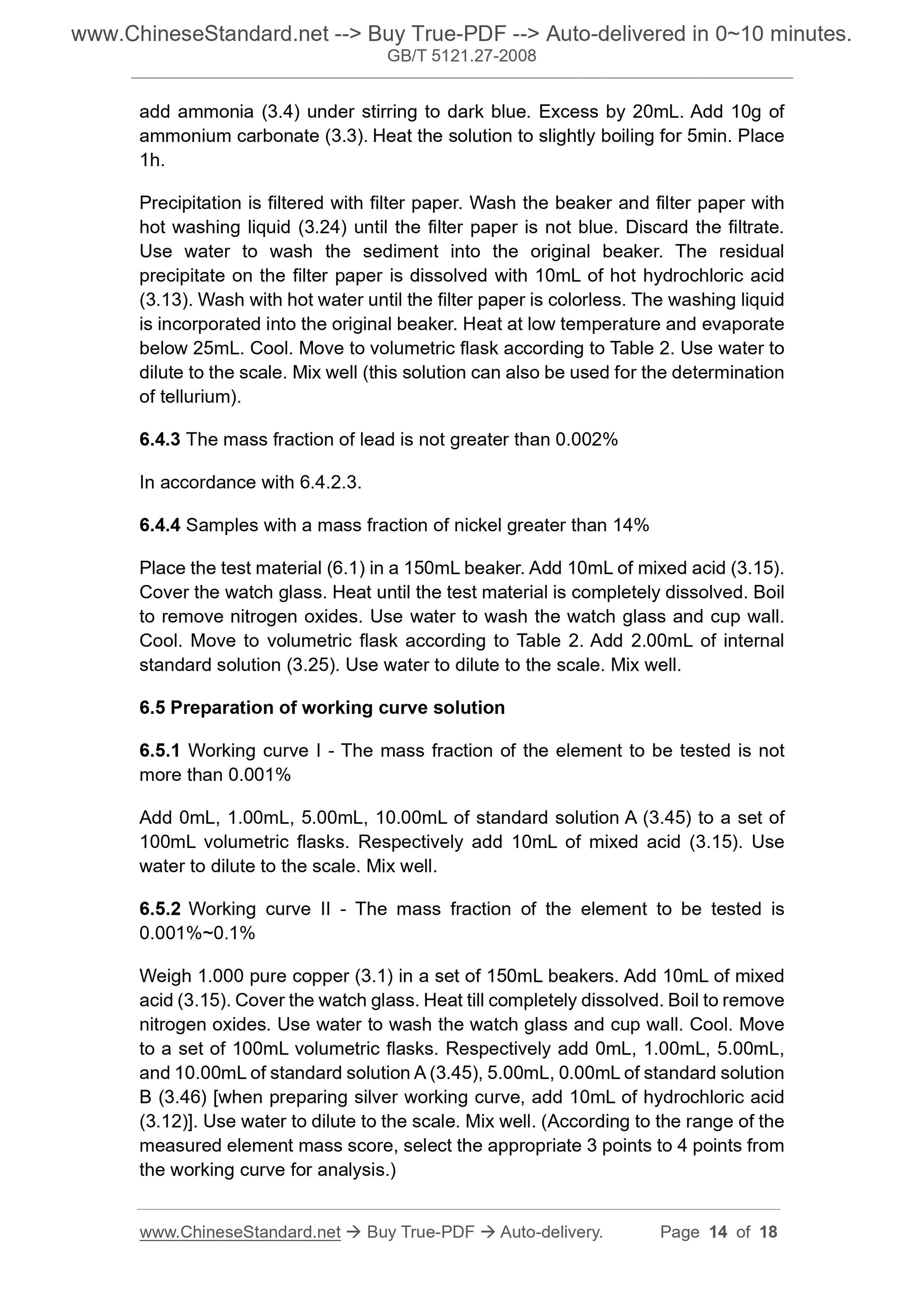1
/
of
7
www.ChineseStandard.us -- Field Test Asia Pte. Ltd.
GB/T 5121.27-2008 English PDF (GB/T5121.27-2008)
GB/T 5121.27-2008 English PDF (GB/T5121.27-2008)
Regular price
$150.00
Regular price
Sale price
$150.00
Unit price
/
per
Shipping calculated at checkout.
Couldn't load pickup availability
GB/T 5121.27-2008: Methods for chemical analysis of copper and copper alloys - Part 27: The inductively coupled plasma atomic emission spectrometric method
Delivery: 9 seconds. Download (and Email) true-PDF + Invoice.Get Quotation: Click GB/T 5121.27-2008 (Self-service in 1-minute)
Newer / historical versions: GB/T 5121.27-2008
Preview True-PDF
Scope
This Part specifies inductively coupled plasma emission spectrometric methodfor 25 elements of phosphorus, silver, bismuth, antimony, arsenic, iron, nickel,
lead, tin, sulfur, zinc, manganese, cadmium, selenium, tellurium, aluminum,
silicon, cobalt, titanium, magnesium, beryllium, zirconium, chromium, boron,
mercury in copper and copper alloys.
This Part is applicable to simultaneous determination of multiple elements of
phosphorus, silver, bismuth, antimony, arsenic, iron, nickel, lead, tin, sulfur, zinc,
manganese, cadmium, selenium, tellurium, aluminum, silicon, cobalt, titanium,
magnesium, beryllium, zirconium, chromium, boron, mercury in copper and
copper alloys. It is also applicable to independent determination of an element.
See Table 1 for the determination range of each element.
Table 1 -- Determination range of each element
manganese in 1mL.
3.27 Phosphorus standard stock solution: Weigh 0.4394g of potassium
dihydrogen phosphate (superior grade pure) in a beaker. Add 100mL of nitric
acid (3.10). Stir to make it dissolve. Move into a 1000mL volumetric flask. Use
water to dilute to the scale. Mix well. 1mL of this solution contains 100μg of
phosphorus.
3.28 Bismuth standard storage solution: Weigh 1.0000g of pure bismuth (the
mass fraction of bismuth is not less than 99.95%) in a 200mL beaker. Add 50mL
of nitric acid (3.8) to dissolve under low temperature heating. Cool. Move into a
1000mL volumetric flask. Use water to dilute to the scale. Mix well. 1mL of this
solution contains 1mg of bismuth.
3.29 Antimony standard stock solution: Weigh 0.1000g of pure antimony (the
mass fraction of antimony is not less than 99.95%) in a 150mL beaker. Add
20mL of hydrochloric acid (3.12). Add a few drops of nitric acid (3.8) to dissolve
at low temperature heating. Cool. Move into a 1000mL volumetric flask. Add
80mL of hydrochloric acid (3.12). Use water to dilute to the scale. Mix well. 1mL
of this solution contains 100μg of antimony.
3.30 Arsenic standard storage solution: Weigh 0.1320g of arsenic trioxide
(As2O3) which has been pre-baked at 100°C~110°C for 2h and cooled to room
temperature in a desiccator into a 150mL PTFE beaker. Add 10mL of sodium
hydroxide solution (3.18). Heat to dissolve. Cool. Move into a 1000mL
volumetric flask. Add water to 200mL~300mL. Add 2 drops of phenolphthalein
ethanol solution (3.20). Use nitric acid (3.9) to neutralize until the solution
changes from red to colorless. And excess by 10mL. Use water to dilute to the
scale. Mix well. 1mL of this solution contains 100μg of arsenic.
3.31 Iron standard storage solution: Weigh 1.0000g of pure iron (the mass
fraction of iron is not less than 99.95%) in a 150mL beaker. Add 40mL of
hydrochloric acid (3.12). Heat till it is completely dissolved. Cool. Move into a
1000mL volumetric flask. Use water to dilute to the scale. Mix well. 1mL of this
solution contains 1mg of iron.
3.32 Tin standard storage solution: Weigh 1.0000g of pure tin (the mass fraction
of tin is not less than 99.95%) in a 150mL beaker. Add 30mL of hydrochloric
acid (3.12), a few drops of nitric acid (3.8). After dissolving by heating at low
temperature, transfer to a 1000mL volumetric flask. Add 70mL of hydrochloric
acid (3.12). Use water to dilute to the scale. Mix well. 1mL of this solution
contains 1mg of tin.
3.33 Sulfur standard stock solution: Weigh 0.5436g of potassium sulfate
(excellent grade pure) in a 250mL beaker. Add a small amount of water to
dissolve. After completely dissolved, transfer to a 1000mL volumetric flask. Use
Shake well. Re-evaporate to emit a small amount of sulfur trioxide smoke. Cool.
Slowly purge about 25mL of water. Mix well. Cool. Move into a 1000mL
volumetric flask. Use water to dilute to the scale. Mix well. Store in a plastic
bottle. 1mL of this solution contains 100μg of zirconium.
3.40 Chromium standard stock solution: Weigh 2.8280g of potassium
dichromate (K2Cr2O7, excellent grade pure) pre-baked at 140°C for 2h and
cooled to room temperature in a desiccator INTO a 400mL beaker. After
dissolving with a small amount of water, transfer to a 1000mL volumetric flask.
Use water to dilute to the scale. Mix well. 1mL of this solution contains 1mg of
chromium.
3.41 Silver and magnesium standard stock solutions: Respectively weigh
0.1000g of pure silver and pure magnesium (the mass fraction of silver and
magnesium is not less than 99.95%) in a set of 150mL beakers. Add 10mL of
nitric acid (3.9). Heat to dissolve. Boil to remove nitrogen oxides. Cool.
Respectively move into 1000mL volumetric flasks. Use water to dilute to the
scale. Mix well. This set of solutions contains 100μg of silver and 100μg of
magnesium in 1mL.
3.42 Standard stock solution of selenium and tellurium: Respectively weigh
0.1000g of pure selenium and pure tellurium (selenium, tellurium mass fraction
is not less than 99.95%) in a set of 150mL beakers. Add 10mL of nitric acid (3.9).
Heat to dissolve. Boil to remove nitrogen oxides. Cool. Add 50mL of nitric acid
(3.8). Respectively move into 1000mL volumetric flasks. Use water to dilute to
the scale. Mix well. This set of solutions contains 100μg of selenium and 100μg
of tellurium in 1mL.
3.43 Boron standard stock solution: Weigh 0.5715g of boric acid (H3BO3,
excellent grade pure) to dissolve in a small amount of water. Move into a
1000mL volumetric flask. Use water to dilute to the scale. Mix well. Store in a
plastic bottle. 1mL of this solution contains 100μg of boron.
3.44 Mercury standard stock solution: Weigh 0.1354g of mercury dichloride
(excellent grade pure) in a beaker. Add 100mL of hydrochloric acid (3.13). Stir
to dissolve it. Move into a 1000mL volumetric flask. Use water to dilute to the
scale. Mix well. 1mL of this solution contains 100μg of mercury.
3.45 Standard solution A: Dilute the standard stock solution (3.26-3.44) to 10μg
per ml. And maintain the same acidity as the standard stock solution.
3.46 Standard solution B: Dilute the standard stock solution (1mg per ml in 3.26
to 3.40) to 100μg per ml. And maintain the same acidity as the standard stock
solution.
3.47 Certified series of national or industry standard samples.
6.4.1 When the mass fraction of the element to be measured is greater than
0.001% to the upper limit of determination in Table 1 (Ni mass fraction is
0.001%~14%, lead mass fraction is 0.002%~7%)
6.4.1.1 Place the test material (6.1) in a 150mL beaker. Add 10mL~15mL of
mixed acid (3.15). Cover the watch glass. Heat till the test material is completely
dissolved. Use water to wash the watch glass and cup wall. Cool. Move to the
volumetric flask according to Table 2. Use water to dilute to the scale. Mix well.
6.4.1.2 Samples containing silicon, zirconium and titanium
Place the test material (6.1) in a 150mL PTFE beaker. Add 10mL~15mL of
mixed acid (3.15), 2 drops of hydrofluoric acid (3.7). Heat (when silicon is the
element to be measured, the heating temperature shall not exceed 60°C) to
dissolve. After the test material is completely dissolved, add 5mL of boric acid
saturated solution (3.17). Mix well. Move to volumetric flask according to Table
2. Use water to dilute to the scale. Mix well. Transfer to the original PTFE beaker
immediately.
6.4.1.3 Samples containing chromium
Place the test material (6.1) in a 150mL beaker. Add 5mL~10mL of nitric acid
(3.9), 3mL~5mL of perchloric acid (3.6). Cover the watch glass. Heat to dissolve
the sample and evaporate to perchloric acid smoke (about 1min~2min) to make
the solution clear. Remove to cool. Use water to wash the watch glass and cup
wall. Move to volumetric flask according to Table 2. Use water to dilute to the
scale. Mix well.
6.4.1.4 Samples containing silver
Place the test material (6.1) in a 150mL beaker. Add 10mL~15mL of mixed acid
(3.15). Cover the watch glass. Heat till the test material is completely dissolved.
Use water to wash the watch glass and cup wall. Add 10mL of hydrochloric acid
(3.12). Cool. Move to volumetric flask according to Table 2. Use water to dilute
to the scale. Mix well.
NOTE: Weigh 1.0000g of sample. When the mass fraction of silver is greater than 0.3%,
add 10mL~15mL of nitric acid (3.9) to dissolve the sample.
6.4.2 When the mass score of the element to be tested is not greater than 0.001%
6.4.2.1 Selenium and tellurium
Place the test material (6.1) in a 400mL beaker. Add 50mL of nitric acid (3.9).
Cover the watch glass. Heat at low temperature until the sample is completely
dissolved. Cool for a while. Add 10mL of perchloric acid (3.6). Heat up to emit
white smoke 2min~3min. Use water to wash the watch glass and cup wall.
add ammonia (3.4) under stirring to dark blue. Excess by 20mL. Add 10g of
ammonium carbonate (3.3). Heat the solution to slightly boiling for 5min. Place
1h.
Precipitation is filtered with filter paper. Wash the beaker and filter paper with
hot washing liquid (3.24) until the filter paper is not blue. Discard the filtrate.
Use water to wash the sediment into the original beaker. The residual
precipitate on the filter paper is dissolved with 10mL of hot hydrochloric acid
(3.13). Wash with hot water until the filter paper is colorless. The washing liquid
is incorporated into the original beaker. Heat at low temperature and evaporate
below 25mL. Cool. Move to volumetric flask according to Table 2. Use water to
dilute to the scale. Mix well (this solution can also be used for the determination
of tellurium).
6.4.3 The mass fraction of lead is not greater than 0.002%
In accordance with 6.4.2.3.
6.4.4 Samples with a mass fraction of nickel greater than 14%
Place the test material (6.1) in a 150mL beaker. Add 10mL of mixed acid (3.15).
Cover the watch glass. Heat until the test material is completely dissolved. Boil
to remove nitrogen oxides. Use water to wash the watch glass and cup wall.
Cool. Move to volumetric flask according to Table 2. Add 2.00mL of internal
standard solution (3.25). Use water to dilute to the scale. Mix well.
6.5 Preparation of working curve solution
6.5.1 Working curve I - The mass fraction of the element to be tested is not
more than 0.001%
Add 0mL, 1.00mL, 5.00mL, 10.00mL of standard solution A (3.45) to a set of
100mL volumetric flasks. Respectively add 10mL of mixed acid (3.15). Use
water to dilute to the scale. Mix well.
6.5.2 Working curve II - The mass fraction of the element to be tested is
0.001%~0.1%
Weigh 1.000 pure copper (3.1) in a set of 150mL beakers. Add 10mL of mixed
acid (3.15). Cover the watch glass. Heat till completely dissolved. Boil to remove
nitrogen oxides. Use water to wash the watch glass and cup wall. Cool. Move
to a set of 100mL volumetric flasks. Respectively add 0mL, 1.00mL, 5.00mL,
and 10.00mL of standard solution A (3.45), 5.00mL, 0.00mL of standard solution
B (3.46) [when preparing silver working curve, add 10mL of hydrochloric acid
(3.12)]. Use water to dilute to the scale. Mix well. (According to the range of the
measured element mass score, select the appropriate 3 points to 4 points from
the working curve for analysis.)
Basic Data
| Standard ID | GB/T 5121.27-2008 (GB/T5121.27-2008) |
| Description (Translated English) | Methods for chemical analysis of copper and copper alloys - Part 27: The inductively coupled plasma atomic emission spectrometric method |
| Sector / Industry | National Standard (Recommended) |
| Classification of Chinese Standard | H13 |
| Classification of International Standard | 77.120.30 |
| Word Count Estimation | 10,182 |
| Date of Issue | 2008-06-17 |
| Date of Implementation | 2008-12-01 |
| Regulation (derived from) | National Standard Approval Announcement 2008 No.10 (Total No.123) |
| Issuing agency(ies) | General Administration of Quality Supervision, Inspection and Quarantine of the People's Republic of China, Standardization Administration of the People's Republic of China |
| Summary | This standard specifies the phosphorus copper and copper alloys, silver, bismuth, antimony, arsenic, iron, Nickel, lead, tin, sulfur, zinc, manganese, cadmium, selenium, tellurium, aluminum, silicon, cobalt, titanium, magnesium, beryllium, zirconium, chromium, boron, Mercury 25 elements by inductively coupled plasma emission spectrometry methods. This section applies to copper and copper alloys phosphorus, silver, bismuth, antimony, arsenic, iron, Nickel, lead, tin, sulfur, zinc, manganese, cadmium, selenium, tellurium, aluminum, silicon, cobalt, titanium, magnesium, beryllium, zirconium, chromium, boron, multi-element determination of elemental mercury levels at the same time. Also applies where an independent determination of an element. |
Share
